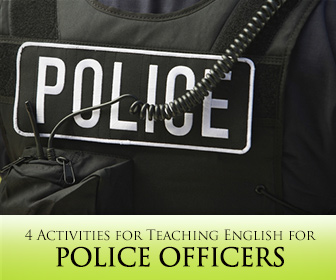Stop Right There!: ESP for Police Officers


Unfortunately, these are some of the included risks when we travel. Fortunately, police are the people you can go to for help when these incidents happen. Communication is of the utmost importance when it means getting your money returned safely, so teaching English for specific purposes (ESP) for police officers is a significant job!
Here are some activities to help police officers learn English.

Many times, police officers need to rely on victims’ descriptions of the criminals to assist them. This means police officers need to be able to understand adjectives and descriptive phrases very clearly. One way to do this is to divide your students in half: half will be the police officers and half will be the victims. Ask all of the police to leave the room, and show the remaining students a picture of the “criminal.” Alternatively, you could show them a short video clip of a purse snatching in action to give students practice describing the event that happened. Only show the video once to make it as realistic as possible. Bring the students assigned to the police back in the room and assign each police officer to a victim. The police officer must take notes carefully and ask prompting questions to get as good of a description of the suspect as possible. When all pairs have finished, put a “line-up” on the computer screen of 6 potential criminals, only one of which is the same individual that you showed to the victims. Give each suspect a number to make identification easier. Making sure your victims don’t give away the answer to their police officers, and ask the police officers to write down the number of the person they think committed the crime.
As an alternative to this activity, keep all of your students in the room and work on an unrelated activity, for example, writing incident reports. Arrange for a friend or fellow teacher (make sure it’s someone the students don’t already know) to run into the room and steal something from your desk. Ensure that your students are surprised when it happens! After the “thief” leaves the room, split the students into pairs and have them take turns asking questions to each other about the incident that they were all witnesses to. Have them write down as much information as possible about the thief. When they are done, share the answers as a class to come up with a single description. When you’ve compiled a class description, bring your friend back into the room to see how accurate their eyewitness accounts were. If they missed several details (which statistics say they likely would get several details wrong), use this to springboard into a conversation about the reliability (or unreliability) of eyewitness accounts and how they should take this into account when working.
A large part of police work is the paperwork. Whether it’s helping new residents get a residency permit or documenting a crime, police officers need to know how to communicate one on one to achieve various goals. Police officers need to be prepared for individuals with limited English along with native English speakers, so try to prepare them with a variety of accents. Practice role plays to help students get used to speaking with foreigners who need to accomplish a specific task, like apply for residency or report a crime. Create generic forms to give students practice filling in the paperwork.
When working with distraught individuals, the tone of voice and quality of English can change, making listening more complicated. When you practice listening, make sure you do a variety of tones to practice hearing and recognizing emotion through intonation. Bear in mind this may vary culture to culture, so give your students the broadest practice possible in listening to different tones. Visit YouTube to find different videos with varying tones of voice. Have students listen and do dictations for what they hear, or take notes to get the gist of the situation. Also, a key part of this practice would be identifying the emotion they hear in the voice.
The best way to listen and comprehend different tones is to produce them. Have your students practice reading dialogues varying only the tone of their voice to fit a specific context. For example, take a rather neutral dialogue like the following:
Now, give students a context to practice this dialogue. For example, you could have two police officers who haven’t seen each other in a while, a tourist and a shopkeeper, a suspected criminal and a police officer, two people who vaguely remember each other but they’re not sure from where, one person has just lost their wallet and they’re looking for it while the other person is distracting them, etc... The focus of this activity is not on the words that are being said, but how they’re being said and varying the intonation and emotion in conversation. After students have mastered this, apply these different tones to potential role plays that police officers will likely encounter.
Although a standard practice in any classroom, role plays have a special role in ESP classrooms. Role plays simulate the environment that your students will be entering for their job, so make them as realistic as possible. Consider doing the following role plays for police officers:
Teaching ESP to police officers is a serious business! Make sure you do some activities that will help your students recall and effectively use language, even in stressful situations.